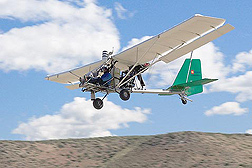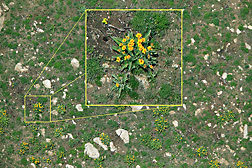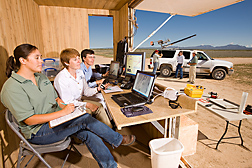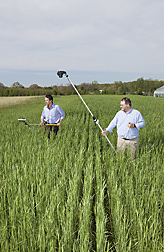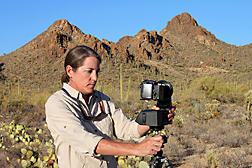Photographing Land Changes From Low in the Sky
Three years after the Deep Fire Burn, a devastating wildfire that burned 38,000 of the Medicine Lodge Project Area’s 54,683 acres, northwest of Dubois, Idaho, pilot Joe Nance is flying just over 300 feet above the area, going north from the Upper Snake River Plain to the Continental Divide on the Montana-Idaho border. He is flying a Moyes-Bailey Dragonfly, a two-seat light sport airplane with a 34-foot wingspan. He sees a landscape covered in native mountain big sagebrush interspersed with native fescue grass—and the invasive leafy spurge.
As he flies at 40 to 60 miles per hour, every 1,000 feet the plane’s special navigation system automatically triggers two digital cameras mounted on the side of the airplane and powered and triggered by GPS-interfaced equipment in the second seat. An 11-megapixel camera has a 100-millimeter (mm) lens, and a 16-megapixel camera has a special 840-mm lens. Both have the fast shutter speeds needed for clear, high-resolution photos from a low-flying airplane. The pilot will fly 25 different flight lines across the survey area, triggering more than 1,400 pairs of photographs for later computer analysis.
One camera takes images at a 1- by 1-mm resolution, the other at a 10- by 10-mm resolution. Usually the plane is outfitted with three cameras, with the third camera providing a 20-mm resolution.
Leafy Spurge Displacing Mountain Big Sagebrush
Using this survey method, called Very Large Scale Aerial (VLSA) imagery, Agricultural Research Service rangeland specialist Terry Booth and colleagues discovered that leafy spurge was displacing sagebrush seedlings. “We believe this is the first evidence of this,” Booth says.
Overall, the research shows that the VLSA survey method, developed by Booth, is a good way to sample vast areas of the western United States. “We recommend that it be used with ground-based methods for early detection of invasive species that might threaten native plant populations,” Booth says.
Pesticides and biological-control insects were used to control leafy spurge before and after the burn. But leafy spurge still managed to expand in drainage areas and up canyon slopes.
“The type of aerial survey we did can be repeated to keep checking on whether the pesticides or insects are working,” Booth says.
Booth is in the ARS Rangeland Resources Research Unit, in Cheyenne, Wyoming.
He received funding and technical assistance from the U.S. Department of the Interior’s Bureau of Land Management (BLM).
For this type of high-resolution aerial photography, Booth found that a 10-mm resolution worked better than 1 mm for detecting leafy spurge because it gives the best balance between resolution and field of view. “But,” Booth says, “the 1-mm resolution was often needed to confirm spurge identity. There are times when we need the 20-mm resolution, so it depends on whether we need a wider field of view, or need more details. It’s best to have multiple resolutions available.”
The larger field of view of the 20-mm resolution images help Booth locate areas on large U.S. Department of Agriculture (USDA) color infrared images taken at a 3- by 3-foot resolution.
Advances in cameras, image sensors, storage media, and image processing have moved monitoring natural resources by aerial photography to these new realms.
Flying From East to West
ARS scientists throughout the nation are using aerial photography to monitor a variety of lands with digital cameras and sensors, from the flat lands of the Chesapeake Bay’s Maryland Eastern Shore to the national parks, forests, mountains, and deserts of the West. The cameras and sensors are flown aboard all sorts of aircraft—from regular small passenger planes to light airplanes like the Dragonfly to unmanned aerial vehicles (UAVs).
Besides Idaho, Booth has also done aerial surveys in Colorado, Nevada, New Mexico, North Dakota, South Dakota, Oklahoma, and Wyoming, looking at a variety of vegetation, including invasive and native trees, juniper woodlands, grasslands, and shrublands—on sites as diverse as gas pipeline rights-of-way and riverbanks.
Booth did the Idaho survey in mid-July, when leafy spurge was flowering, because colleague Ray Hunt found that was the easiest stage to identify spurge. Hunt developed a technique to detect leafy spurge by its showy yellow-green flowers, which bloom in June and July. Hunt is a physical scientist at the ARS Hydrology and Remote Sensing Laboratory in Beltsville, Maryland.
NASA Aircraft
Hunt has used the National Aeronautics and Space Administration’s (NASA) Airborne Visible Infrared Imaging Spectrometer sensor flown aboard NASA aircraft over public lands in the West. NASA’s advanced sensor can detect leafy spurge only when there are color differences compared to the surrounding vegetation. VLSA imagery may be able to detect invasive weeds based on leaf shape, even when color differences are not apparent.
In fact, Hunt and Dean Hively, a scientist with the U.S. Geological Survey who is stationed at Beltsville, have added color infrared capability to commercial digital cameras using a method patented jointly by ARS and David Linden, currently with Science Applications International Corporation, headquartered in McLean, Virginia. They did this by choosing a 12-megapixel camera sold without an internal filter that blocks near-infrared (NIR) light. All they had to do then was add a custom-made lens filter to block red light and transmit the NIR. The result is a camera that photographs with light in the NIR, green, and blue bands—which are needed to measure the “greenness” of vegetation and extent of crop canopy cover. “There is no need for further processing, so the images are available immediately upon landing,” Hunt says. “The cameras are also lighter and more compact than the traditional large-format cameras used for aerial infrared photography,” Hively adds.
They have found the photographs useful for detecting the extent of coverage from winter wheat and other winter cover crops in the Chesapeake Bay Watershed.
Flying Without a Pilot
Hunt and Hively use their cameras aboard both airplanes and small UAVs. UAVs can fly as low as a few hundred feet. With only a regular camera lens, the scientists get a resolution of 1 square inch. “This is enough to measure areas covered by crops, but we’d like to put a fast telephoto lens, like the one Booth uses, onto our camera system to identify plant species and to measure the amount of chlorophyll in a single leaf of a crop,” Hunt says. “Chlorophyll in leaves may indicate the amount of nutrients in the soil, so VLSA imagery may be a way to help farmers save money by applying fertilizers more efficiently, which also helps protect the Chesapeake Bay.”
The infrared digital cameras add to the advantages of aerial photography because living vegetation strongly reflects NIR light, eliminating confusion from soil reflectance and shadows that can hide vegetation.
So, Booth, in turn, recently made space for one of Hunt’s cameras on the Dragonfly.
“Regular infrared photography has too slow a shutter speed for use in low-altitude, high-resolution aerial photography,” Booth says. “But that technology is advancing too, and Hunt and Hively are helping that along.”
At the USDA-ARS Jornada Experimental Range in Las Cruces, New Mexico, Al Rango, Jeffrey Herrick, and Craig Winters, ARS scientists based at the range, and Andrea Laliberte, a New Mexico State University researcher, are studying the use of a UAV that cruises 700 feet above the Earth, collecting digital photographs of rangeland areas so large they are difficult to cover in ground-based surveys. The aircraft weighs 20 pounds, has a 6-foot wingspan, and is launched from a catapult.
Satellite imagery is improving, but satellites can’t provide the resolution needed by BLM for assessments of millions of acres of federally owned lands. UAVs allow operators to survey line-of-sight areas repeatedly or immediately after a major rainstorm or forest fire. When photographs must be obtained in conditions that would put a pilot at risk, UAVs have the advantage over manned airplanes, and they can acquire imagery at very high resolution.
The goal of using aerial imagery is to measure rangeland vegetation cover as well as collect enough information about landscape patterns to determine which areas merit closer ground level surveys, Laliberte says. Booth adds that aerial photography reduces the number of ground surveys needed. “But before you can analyze aerial photography of, say, plant communities, you need a lot of experience identifying the plant communities on the ground.”
In a study partially funded by BLM, the researchers flew the UAV over the ARS Reynolds Creek Experimental Watershed in southwestern Idaho. They took just over 400 aerial photographs of 700 acres over 2 days. The researchers assembled the images into three mosaics, determined the percentage of vegetation cover using image-processing techniques, and compared the data to information collected with conventional ground-based measurement techniques.
Digital Mosaics
In a second study, the researchers looked at the classification accuracy of different types of vegetation, such as mesquite and yucca plants, identified by a computer program designed to analyze mosaics assembled from hundreds of digital images taken during flights over two tracts in Idaho and two in New Mexico.
In both studies, they found the aerial data sufficiently accurate to be comparable to information gathered in ground-based surveys for shrubs, grasses, and other plants that can be distinguished by their top canopy layer. This UAV aerial data is not the same as 1- by 1-mm resolution data, but it can be the right resolution for other important information needs, Booth notes.
Current federal safety requirements and associated costs limit the use of UAVs. Even with a Certificate of Authorization from the Federal Aviation Administration, UAVs are not allowed to be flown out of sight of ground operators. But this and other restrictions may change in the future. The research on UAVs is designed to ensure that the strengths and weaknesses of the technology are sufficiently understood regardless of the status of the regulations.
Ultimately, UAVs and other aircraft are tools for remote sensing, along with satellites, digital cameras, infrared cameras, and infrared imaging sensors, Booth says. “You can use any one of these or any combination of these, depending on your needs. The exciting part is that all of these technologies are advancing at a quick pace.”—By Don Comis and Dennis O'Brien, Agricultural Research Service Information Staff.
This research is part of Pasture, Forage, and Rangeland Systems (#215) and Climate Change, Soils, and Emissions (#212), two ARS national programs described at www.nps.ars.usda.gov.
To reach scientists mentioned in this article, contact Don Comis, USDA-ARS Information Staff, 5601 Sunnyside Ave., Beltsville, MD 20705-5129; (301) 504-1625, donald.comis@ars.usda.gov.
Unlike some other Agricultural Research Service researchers, hydraulic engineer Mary Nichols prefers to keep her feet—and imaging equipment—on the ground. In 2008, she began participating in Carnegie Mellon’s Fine Outreach for Science Fellows Program, which allowed her to explore how rangeland ecologists could use high-resolution digital panoramas to track landscape changes. (Because of the Fine Outreach Fellowship, Nichols is sometimes referred to as a “Fine Fellow.”)
“This technology is perfect for rangelands, because all rangeland scientists take photos,” says Nichols, who works at the ARS Southwest Watershed Research Center in Tucson, Arizona. “It’s a great opportunity for taking photographic monitoring up several notches.”
The process for creating these panoramas was developed by Carnegie Mellon University and Charmed Labs, LLC, in collaboration with the Intelligent Robotics Groups at NASA’s Ames Research Center in Moffett Field, California, and support from Google. A digital camera is placed on a robotic camera mount and takes a series of pictures as the mount rotates. A custom computer program stitches the pictures together to create a panoramic image. In the end, hundreds—and sometimes thousands—of individual detailed photographs become part of a single high-resolution landscape panorama that users can zoom in on to study individual plants, animals, or geomorphic features in the surrounding landscape.
In October and November of 2008, Nichols created three rangeland panoramas in Arizona to see whether scientists could use the images to monitor riparian areas, wildlife, or invasive plants. The resulting panoramas were so detailed that she could count the elk in a distant herd—and even evaluate the condition of each animal.
|
|
Nichols could also identify stands of invasive buffelgrass, which turns golden yellow in the fall and presents a striking contrast to surrounding vegetation. With this information in hand, it was possible to document the extent of the buffelgrass invasion in the Santa Catalina Mountains, which provided a baseline assessment of the plant’s establishment that could be used to track its subsequent spread.
Researchers can share their panoramas by posting them on www.gigapan.org.
“I’m also collaborating with University of Arizona researchers to develop a website specifically for high-resolution rangeland panoramas,” Nichols says. “For instance, we could use this type of imaging to compare old photos from the 1930s and 1940s to current photographs and measure changes in plant communities and other geomorphic factors.”—By Ann Perry, Agricultural Research Service Information Staff.
"Photographing Land Changes From Low in the Sky" was published in the September 2011 issue of Agricultural Research magazine.








